I. WHAT ARE RELATIVE CLAUSES?
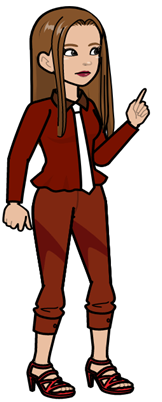
I. WHAT ARE RELATIVE CLAUSES?
There are two types of Relative Clauses: Defining and Non-defining relative clauses.
I.1 DEFINING RELATIVE CLAUSES
They are used to help identify which person, place or thing you are talking about. We need to put two sentences together, joined by a relative pronoun or adverb. The additional sentence is used to highlight relevant, essential or necessary information about the noun previously mentioned within the sentence. This type of clause does not require a comma. For example:
a) Mr. Jones has a son.
b) His son is a musician.
Mr. Jones has a son who (that) is a musician.
a) That´s the man.
b) The man helped me carry my groceries.
That´s the man who (that) helped me carry my groceries.
As said before, in Defining Relative Clauses, we need to use relative pronouns. These pronouns may be the following :
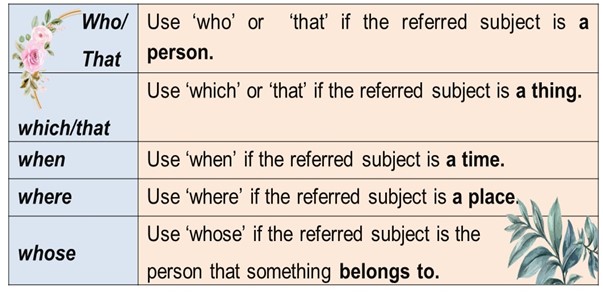
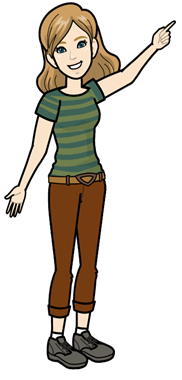
PROCEDURE: Here are some examples of how TWO simple sentences are merged into ONE. As a result we have a relative clause.
a) Christmas is the season.
b) I am the happiest at Christmas.
Result 1: Christmas is the season when I am the happiest.
- That is the church.
- My sister got married there (in that church).
Result 2: That´s the church where my sister got married.
a) Greg bought a camera.
b) The camera doesn’t work.
Result 3: Greg bought a camera which/ that doesn’t work.
Here are a few more examples :
- A chef is someone who (that) cooks at restaurants.
- The hotel where we stayed on our last vacation is very comfortable.
- The job which (that) Andie has at present is well paid.
1.2 NON-DEFINING RELATIVE CLAUSES
These are used to give absolutely extra information about a certain noun. This extra information will be separated from the main clause by commas. For example:
- My favorite food, which is pasta, is best enjoyed with a glass of wine.
- Winter, which is my favorite season, only lasts a few months.
- Rihanna, who was born in Barbados, became a worldwide star in the early 21st century.
- Michael Jordan, whose accomplishments include six NBA Awards, is the principal owner of the Charlotte Hornets of the NBA.
In Non-Defining Relative Clauses we also need to use relative pronouns. These pronouns may be the following :
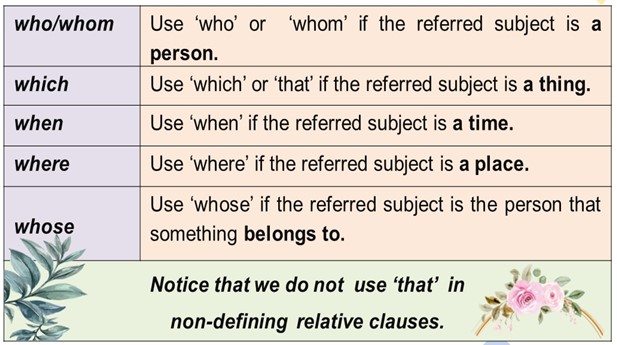
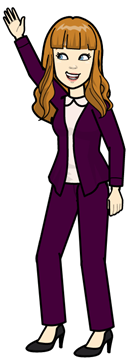
Here are a few more examples:
- My friend Allyson, who is very kind, lives in Toronto, Canada.
- The red handbag, which I purchased last week, was unexpensive.
- The laptop, which I just bought at Sam´s, was $499.00
- Jessica L. O´Connor, who works in the Accounting Department, where I also work, always arrives late.
- Lily's parents, who are lawyers, have just gotten divorced.
- My friend Jackie, who studied marine biology, has recently moved to Japan.
- We stopped at the Soumaya museum, which we had never visited before.
II. CONSOLIDATION
NOW TRY THE FOLLOWING QUIZ. Choose the correct answer to complete the following sentences. Use lower-case letters.
III. LANGUAGE USE PRACTICE
EXERCISE I. Choose the correct option to complete the following sentences correctly.
IV. READING COMPREHENSION AND VOCABULARY BUILDING

- WORK PLACES IN BRITISH COLUMBIA, CANADA
State the responsibilities of employers, workers, and others at the workplace. A safe workplace is one that has a variety of people working together to ensure proper workplace safety is followed. Each person has a certain responsibility, and if each does her or his part, a safe workplace should result. The Workers Compensation Act (WCA) identifies the responsibilities of three main groups. In some cases an individual may have responsibilities in more than one group. Let us consider the following categories: owner, employers, workers, supervisors suppliers and others. Part 3, Division 3, Sections 115–124 of the WCA identify the general duties of employers, workers, and others in the workplace.
Employers’ workplace responsibilities
The WCA identifies responsibilities that are common to all places of employment. To ensure health and safety, the employer must remedy workplace hazardous conditions and ensure that workers:
- are aware of known or foreseeable hazards of their work
- comply with the Act and Regulation
- are made aware of their rights and duties
- establish occupational health and safety policies
- provide and maintain protective equipment, devices, and clothing as required.
- provide information, instruction, training, and supervision to workers in carrying out their work.
- make a copy of the Act and Regulation available for review by workers.
- co-operate with workplace safety representatives and WorkSafeBC.
Workers’ workplace responsibilities
According to the WCA, the worker is responsible for his or her own safety on the job as well as the safety of others. The Act states that every worker must:
- carry out work in accordance with established safe work procedures.
- use and wear protective equipment, devices, and clothing as required.
- not engage in horseplay or similar conduct that endangers the worker or others.
- ensure that the worker’s ability to work is not impaired by alcohol, drugs, or other causes.
- co-operate with workplace safety representatives and WorkSafeBC.
- report the following to the supervisor or employer:
- issues contravening the Act or Regulation.
- defects in or absence of protective equipment, devices, and clothing.
- existence of any hazards that the worker considers potentially dangerous.
Supervisors’ workplace responsibilities
To ensure the health and safety of the workers under their direct supervision, a supervisor must:
- be knowledgeable about the Act and any regulations that apply to their workplace.
- ensure workers are made aware of all known or reasonably foreseeable health or safety hazards in the area where they work.
- consult and co-operate with workplace safety representatives and WorkSafeBC.
Owners’ workplace responsibilities
Every owner of a workplace must:
- provide and maintain the owner’s land and premises that are being used as a workplace in a manner that ensures the health and safety of persons at or near the workplace.
- give to the employer or prime contractor at the workplace the information known to
- the owner that is necessary to identify and eliminate or control hazards to the health or safety of persons at the workplace.
Suppliers’ workplace responsibilities
Every supplier must:
- ensure that any tool, equipment, machine, or device, or any biological, chemical, or physical agent supplied by the supplier is safe when used according to the directions provided by the supplier.
- ensure that any biological, chemical, or physical agent supplied by the supplier is labelled according to the applicable federal and provincial legislation.
- maintain any tool, equipment, machine, or device in safe condition if the supplier has responsibility under a leasing agreement to maintain it.
V. PRACTICE I
INSTRUCTIONS_Questions 1-5
Match column A with the corresponding information in column B. Drag and drop or write A-E in the parenthesis.
VI. PRACTICE II
INSTRUCTIONS_Questions 6-10_Choose the correct answer to complete the following questions or statements correctly.
VII.
BIBLIOGRAPHY
Azar, B. S., Azar, D.A., & Koch R.S. (2009). Understanding and Using English Grammar. Longman.
Barker C. and Mitchell, L. (2004). Mega 1 (First Ed.). Macmillan Publishers.
Hewings, M. (2013) Advanced Grammar in Use with Answers: A Self-Study Reference and Practice Book for Advanced Learners of English. CUP
Murray, L. (2014) English Grammar. Cambridge University Press.
WEB RESOURCES
Images 1,2 & 3 _ Personal subscription to Pixton
REFERENCES
Charts 1&2_Own source .
Image_ Chart 1_https://www.freepik.es/vector-gratis/patron-floracion-invierno-azafran-lavanda_5895420.htm?query=flores
Image_ Chart 2_https://www.freepik.es/vector-gratis/guirnalda-floral-rosa-acuarela-circulo-dorado_15967283.htm#query=flores&position=1&from_view=keyword
CREDITS
- (2021) Practice exercise written by Connie Reyes_Language Department at ENES-LEON UNAM
- Audio version performed by Sally and Matthew_Voicemker_Text to Speech Converter_Connie Reyes 2022 Subscription
- (2021) Practice exercise written by Connie Reyes-Cruz_Language Department at ENES-LEON UNAM
- Text by Camosun College (2015). The Trades Access Common Core resources are licensed under the Creative Commons Attribution 4.0 Unported Licence, except where otherwise noted. Text retrieved from http://open.bccampus.ca
- (2021) Practice exercises written and adapted by Connie Reyes-Cruz_Language Department at ENES-LEON UNAM
- Audio version performed by Sally-Matthew_Voicemker_Text to Speech Converter_Connie Reyes 2022 Subscription
- Free stock photos_ https://www.pexels.com/es-es/foto/persona-mujer-mirando-trabajo-4033304/Photo by Edward Jenner in Pexels